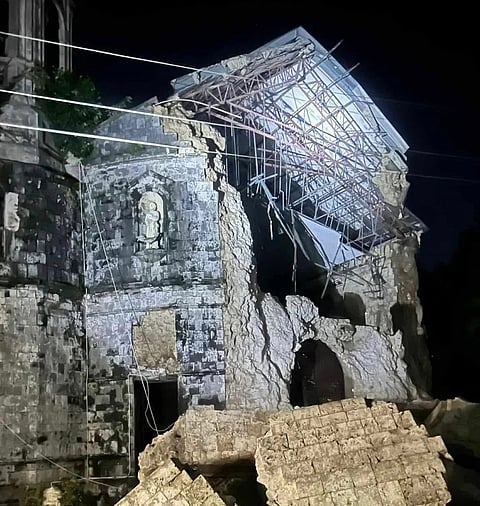Magnitude 6.9 earthquake jolts Philippines, 60 killed
Extensive damage, hundreds of aftershocks reported in Central Visayas region

Manila: A magnitude 6.9 earthquake jolted central Philippines on Tuesday night leaving at least 60 people dead, according to the emergency workers and the Philippine Institute of Volcanology and Seismology (Phivolcs).
Rescue efforts are ongoing.
Heritage sites suffered major damage, while a mall and a covered court reportedly collapsed mid-game when the tremor struck at 9.59pm (13.59 UTC).
Dr Teresito Bacolcol, director of DOST-Phivolcs, said they revised upward the quake's power from the initial 6.7 magnitude to 6.9.
Hundreds of aftershocks were reported from midnight till mid morning on Wednesday.
Fatalities had been confirmed on Wednesday (October 1) in San Remigio.
Police and disaster response teams are still assessing the death toll as rescue operations continue, with no exact casualty figures released yet.
Emergency workers stated the local hospitals in Bogo, a popular tourist destination in the northern part of Cebu island, had been "overwhelmed".
In Cebu City, the Philippines' second-largest city after Manila, hospitals were observed treating patients outdoors in open-air tents due to frequent aftershocks, AFP reported.
The quake also inflicted severe damage on northern Cebu’s historic churches.
Social media posts from parishioners revealed that the centuries-old Archdiocesan Shrine of Santa Rosa de Lima in Daanbantayan partially collapsed.
In Bantayan town, videos captured the Parroquia de San Pedro Apostol, another heritage church, swaying violently, with lights flickering and parts of its outer facade crumbling.
In response, several local government units suspended classes at all levels on Wednesday to inspect school buildings for structural safety.
The ongoing assessments aim to ensure no further risks to students and staff as the region grapples with the quake’s aftermath.
Tectonic origin
The quake had a tectonic origin, which struck at a depth of about 10 km with epicentre at 56 km W of Ormoc (population: 191,000), 16 km NE of Bogo, Cebu (pop. 23,500), according to Phivolcs.
Intensity 6 was felt in Cebu City, and in Villaba, Leyte.
Intensity 3 was reported in San Fernando, Cebu and felt in Laoang, Northern Samar.
The tremor was also reportedly felt in Legazpi City, in Albay province.
"Damages and aftershocks possible in Central Visayas region," according to one report.
Cebu City's Pier Terminal 3 was partially damaged following the quake.
Impact details are emerging as assessments continue in the region. No tsunami threat was reported from this event.
The quake was felt in a wide area of the country including the Visayas region, Bicol and parts of northern Mindanao.
Another report stated the earthquake had a 7.0 magnitude.
This is a developing story. Please refresh for updates.
Sign up for the Daily Briefing
Get the latest news and updates straight to your inbox



